More than 150 sovereigns ruled over ancient Rome before the Western Empire fell; the Eastern Empire continued for a little longer. The first Roman emperor was Augustus Caesar in 27 BC, and the last was Romulus Augustulus whose reign ended in 476 AD. Roman sovereigns often took titles like “Augustus,” “Caesar,” and “Imperator” to stress their importance.
In 27 BC, Rome became a republic. This was brought about by Julius Caesar, and his son Octavian (Augustus) is generally considered to be the first Roman emperor. However, some historians believe that Julius Caesar himself was a sovereign as he was very powerful and had absolute control of the Senate.
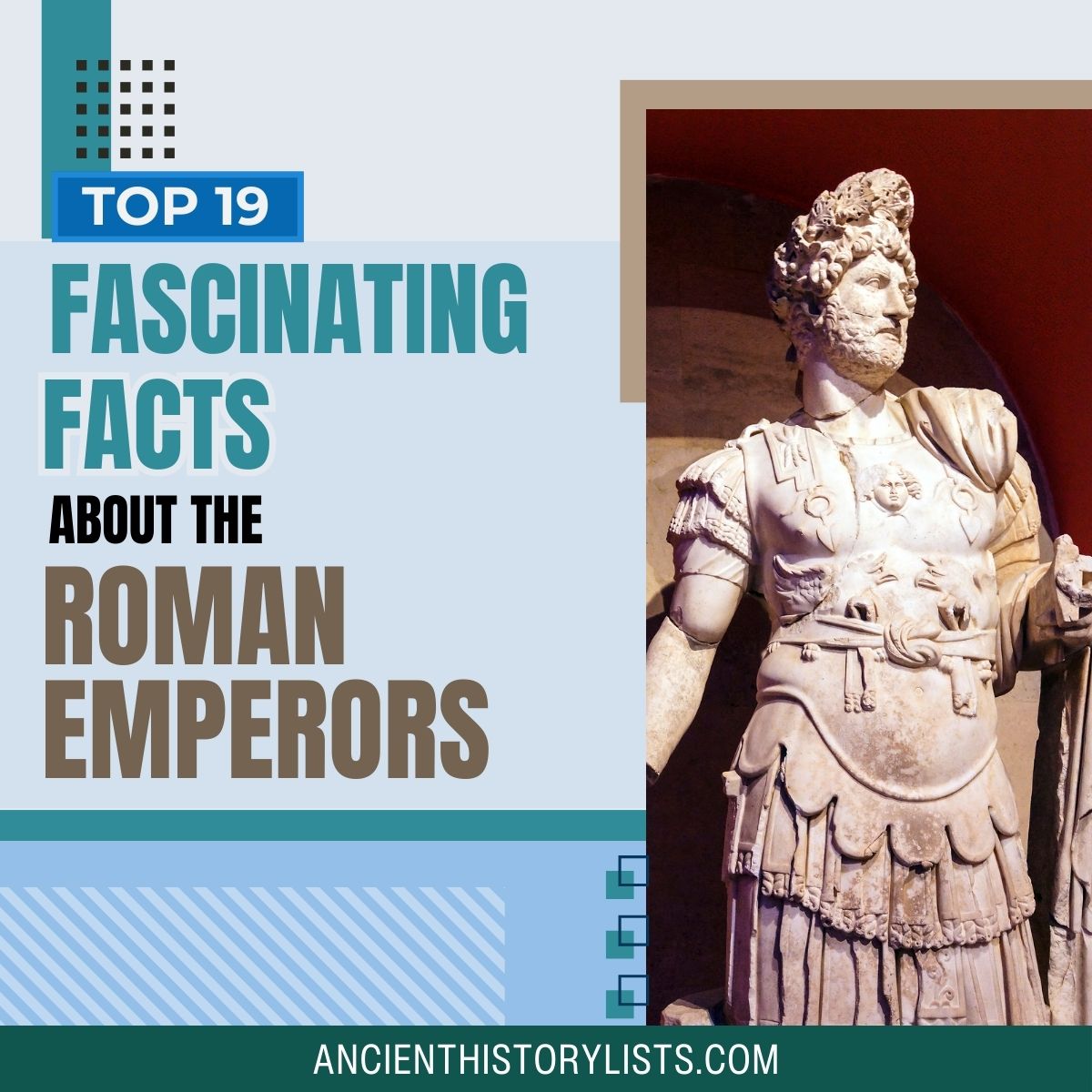
Many of the rulers of ancient Rome contributed to the amazing progress and expansion of the state, while others such as Caligula and Nero brought abuse, fear, and chaos.
Below is a list of the top 19 fascinating facts about these powerful leaders:
1. The Praetorian Guard
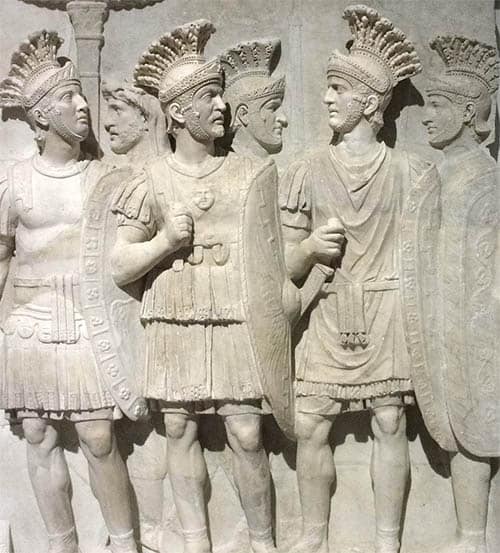
The emperors used an elite military unit called the Praetorian Guard to protect them. Members of the guard were responsible for the safety of the emperor and his family, but they also had other roles such as policing mass gatherings and subduing rebellions.
The Praetorian Guard was a powerful political movement and often interfered in top-level politics. Praetorian prefects were high-level officials within the guard, and they often led the way in plots to overthrow the emperor.
Some of these plots succeeded, as can be seen in Claudius’ rise to power in 41 AD following the destruction of Caligula. The prefects knew that they could expect to receive a generous reward for their support.
2. Challenges to the Emperor
The Battle of Lugdunum, also called the Battle of Lyons, was fought in 197 AD between Emperor Septimius Severus and Clodius Albinus, the administrative ruler of Roman Britain and a challenger to the emperor himself.
An estimated 300,000 Romans are said to have taken part in this battle, 75 percent of the total number of Roman soldiers in the whole of the empire at that time. The fight was evenly balanced, and eventually, Severus was triumphant – just.
3. From First to Last
The first and last Roman heads of state, at least in the west, were both called Augustus. The last emperor took the full name Romulus Augustulus, which was probably a reference to Romulus, one of the twins who is credited with the original foundation of the Roman state
Unfortunately, it became clear that simply naming yourself after a great figure from history wasn’t enough to hold the empire together.
4. Powers of the Emperor
A Roman emperor’s title Princeps Senatus meant that he was head of the Senate, presided over their sessions, guided their discussions, and set out their rules and standards. He had the power to hire and fire at will, call the Senate to session whenever he liked, and veto any of the Senate’s decisions. As Pontifex Maximus, the emperor was the religious leader, with total power over the vestal virgins. He also controlled the country’s finances.
5. Diocletian
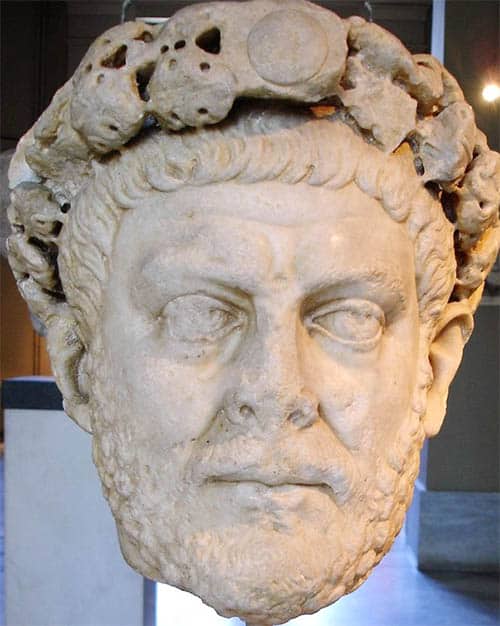
It might appear strange to include Emperor Diocletian in this list, since he is best known for the decision to separate the administration of Rome in two, appointing Marcus Aurelius Maximianus as co-ruler, each with a subordinate known as a caesar, in a four-way power split known as a tetrarchy.
Overall, Diocletian was a decent ruler and able to keep his system of rule together when Rome was under pressure from external enemies. What gets Diocletian included here, however, is his completely savage treatment of Christians.
Christians had, for some time, been respected by most Romans and treated with a blend of dislike and tolerance, yet Diocletian embarked on the all-out annihilation of Christianity. Churches were demolished, sacred texts burnt, and Christian ministers arrested and forced to renounce their religion on pain of death. Christians who didn’t renounce were tormented and executed.
This behavior was truly bizarre as the Romans were usually very tolerant of different religions. It may have been an indication of Diocletian’s own insecurity and fear for survival; Christianity represented a departure from traditional Roman religious beliefs that he could not tolerate.
Diocletian was the first emperor to abdicate in an elaborate abdication ceremony, and this is thought to be due to ill health. He retired quietly to tend his vegetable garden.
6. The Antichrist
It was generally believed that even after his suicide, Nero lived on as the Antichrist. Many people believed that he would return, and the fact that his body was never found strengthened this conviction.
After his death, there were no fewer than three men who professed to be the returned Nero. Christians were convinced that he was the Antichrist who would soon return from hell to torment them.
7. Tiberius
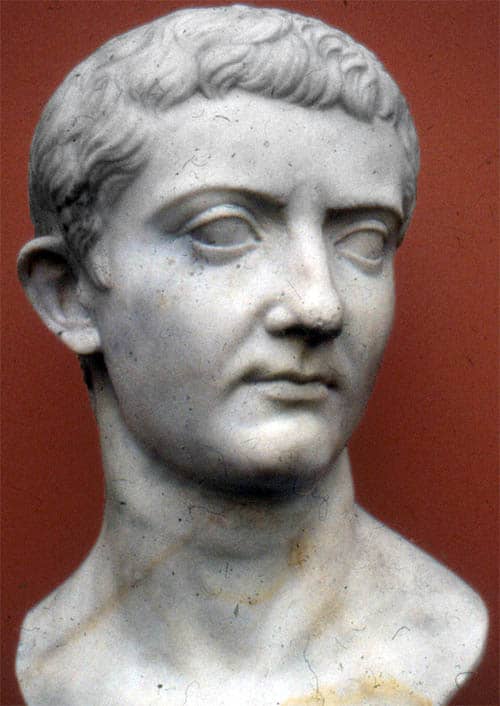
Tiberius was the unlikely successor to Augustus, being an adopted son. Augustus did not expect Tiberius to succeed him, but it was fighting between the emperor’s grandsons Gaius and Lucius (whom Augustus had also adopted), and Augustus’ decision to expel their cousin, Agrippa Postumus, that placed Tiberius in line for succession.
Tiberius was a skilled military officer and member of the Senate. However, he had a suspicious and insecure nature which drove him to remove those whom he saw as a threat. As part of these purges, he exiled Agrippina, the widow of his nephew, the war hero Germanicus.
Tiberius retreated to the island of Rhodes, reinstated the out-of-date charge of maiestas (treachery), and used this to sentence to death anybody he was suspicious of. Roman historians Suetonius and Tacitus describe this retreat as the result of Tiberius’ difficult relationship with his wife who was not faithful to him, but this could be speculation.
Tiberius was not a great leader himself, but rather set the tone for what was to come.
8. Nero

Nero was a ruthless ruler, and he was instrumental in the demise of many men including his mentor, the writer Seneca. He had his own mother killed, and he left his wife, Octavia, for his lover Poppeaea, whom he later married. He exiled Octavia and then had her executed on a fabricated charge of unfaithfulness.
Despite being a brutal and ruthless emperor, Nero was also fond of music and poetry, often forcing people to sit through renditions of his own lengthy compositions. At one point, he insisted on being crowned the winner of the Olympic Games himself. Few sources paint Nero in a favorable light; he was generally a deeply unpopular leader.
9. Gaius (Caligula)
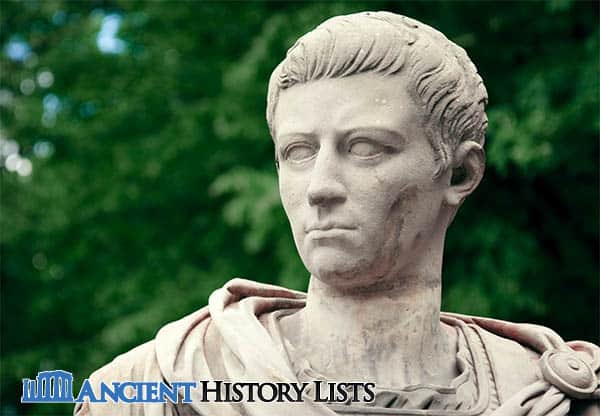
Gaius, otherwise known as Caligula or “little boots,” was best known for the developments he made in naval warfare. Gaius undermined the Senate, declaring that anybody could serve as a senator, even his horse (although it is believed he never went ahead with this appointment). Like Tiberius, he had a habit of getting rid of anyone who challenged him, genuine or imagined.
Despite considering himself divine and immortal, Caligula met his end when he was assassinated by Cassius Chaerea, a member of the Praetorian Guard, during the Palatine Games in 41 AD.
10. Commodus
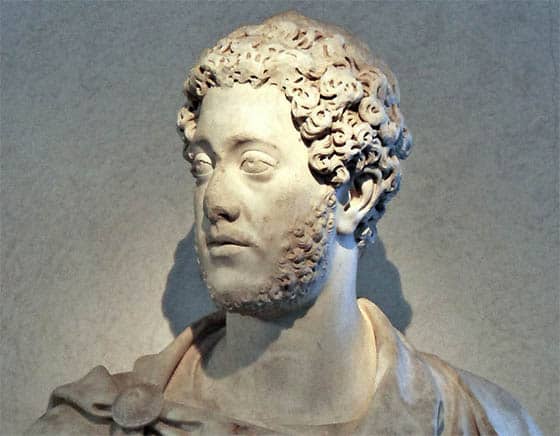
Commodus was the son of Marcus Aurelius and history reports that Commodus was the exact opposite of his father. Vain and self-seeking, Commodus bankrupted the Roman treasury, and in an attempt to boost funds, he killed local noblemen so that he could appropriate their property and sell it off.
Commodus is said to have been a self-centered, sadistic, and cruel king. While his sculptures portray him as a calm figure, the history books say otherwise. He enjoyed watching gladiator fights – the more bloodthirsty the better – especially if they involved injured or disabled fighters.
He declared himself a living god and forced the people to worship him. Not only did he remove the heads of sculptures and replace them with his own image, but he also named most of the months of the year after himself.
Before long, people (including his own sister) were plotting against him. The plots were thwarted, and Commodus continued to execute anyone who he believed was plotting against him, or anyone he thought might do so in the future. He was eventually assassinated by a member of the Praetorian Guard who strangled him in the bath.
11. Eastern Roman Empire
Over time, the Roman Empire extended its borders to such an extent that it became loosely defined as the eastern and western regions. The two zones retained their own distinctive cultures and traditions until, in 293 AD, Emperor Diocletian formally separated east and west and appointed rulers to govern each region separately. This division resulted in the Eastern and Western Roman Empires.
12. The Wolf Twins
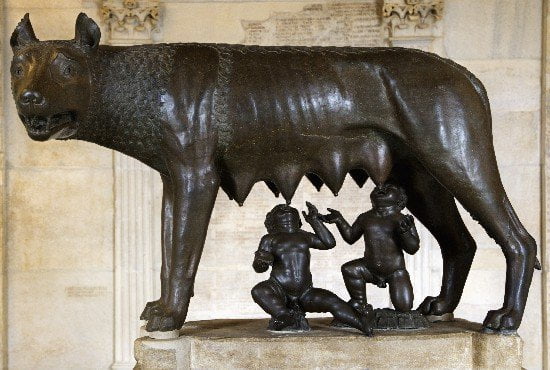
Legend has it that Romulus and his twin brother Remus were abandoned in a forest because they presented a threat to the reigning monarch. They were found and reared by a she-wolf. As the boys reached adulthood, they challenged the king and overthrew him. Unfortunately, Romulus killed Remus in an argument over where the city of Rome should be situated, and the new capital was named after Romulus. He laid the foundations for many traditions, social institutions, and legal systems. A bronze sculpture called the Capitoline Wolf shows Romulus and Remus with their wolf mother, and is an iconic symbol of the foundation of Rome.
13. Death Cap King
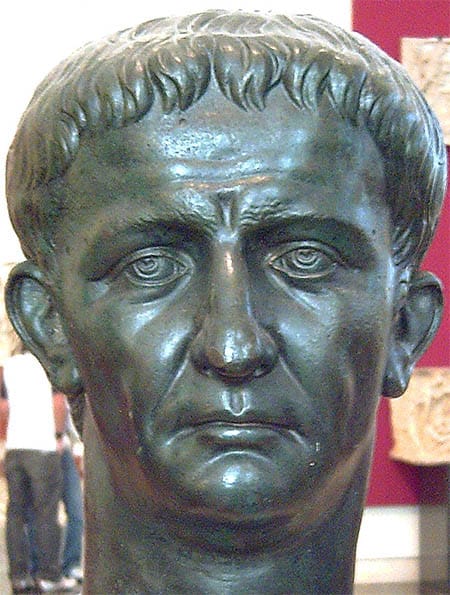
Emperor Claudius was a very well read and knowledgeable emperor, and he had a keen interest in history and writing. He suffered from either cerebral palsy or Tourette’s syndrome and faced many difficulties in his life due to this disability. Claudius is thought to have died from eating poisonous mushrooms called “death cap” mushrooms. It is not known if this was an assassination attempt, but some sources suggest that his wife Agrippina poisoned him so that Nero could ascend the throne.
14. Gloomiest of Men
Tiberius was described so by the historian Pliny the Elder. He never wanted to become king and is best remembered for his solemn and gloomy demeanor. He was, however, a great general: bright and intelligent but in no way interested in ruling the kingdom. During his military career, he conquered many regions such Pannonia and Raetia.
He married Julia the Elder, Augustus’ daughter, thus uniting the bloodlines of two great dynasties. The death of his son led him to depression, and he abdicated and left the city. He was also mentioned in the Bible as it was under his reign that Jesus was put on trial and sentenced to death by crucifixion.
15. Domitian
Domitian was a tyrant king, also mentioned in the Bible, and was the last emperor of the Flavian dynasty. He was continuously at war and was feared by the people and his own senators. He sentenced to death all those who disagreed with him and killed Jews without mercy. It is no surprise then that he was eventually assassinated.
16. Constantine
Constantine the Great was also mentioned in the Bible. He established Christianity as the official religion in Rome, building churches and preaching Christianity all over Europe. His conversion to Christianity is thought to have been down to his mother, Queen Helena, who was deeply religious herself. Constantine was the first-ever Christian Roman emperor.
17. Trajan
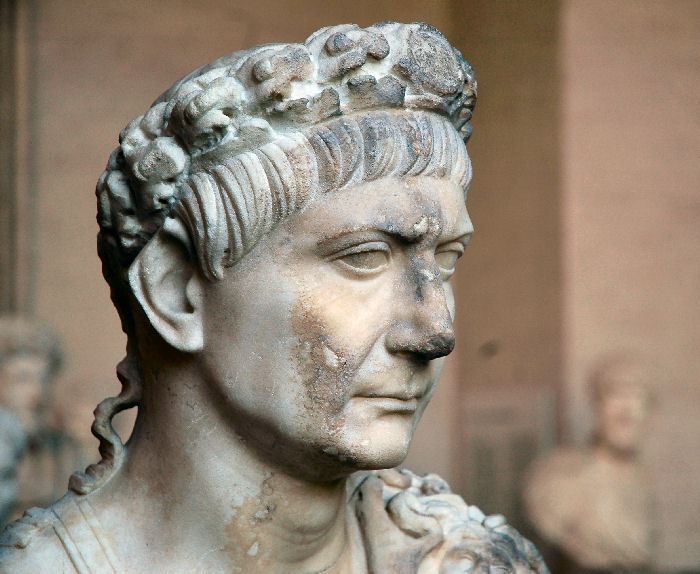
Trajan reigned until 117 AD, and during his time on the throne, he conquered many new lands for the empire. Inevitably, the great geographical size of the empire brought problems in terms of administration, and Trajan found that the empire could not be ruled as a whole. It was maybe his great desire to conquer new lands that ultimately led to his downfall.
18. Vespasian
Vespasian was the fourth emperor of Rome, and the first of the Flavian dynasty. Throughout his reign, he tried to maintain peace and harmony in the city and did all he could to restore law and order after the civil war. He proved himself a worthy ruler of the Roman Empire, and was greatly loved by the people.
19. Good Ruler
Titus Aurelius was a good and capable king. He took his duties seriously and made sure the whole kingdom was happy and at peace. He was nicknamed “cumin splitter” because of his frugality; he would always double-check his officials to make sure they were not wasting anything. He managed tax and business well, and his reign was calm and peaceful. He built many roads and bridges, and improved the empire’s infrastructure. Rome prospered under his rule.
Conclusion
For the first 500 years of its history, no single person held absolute power in Rome, but that all changed over the 500 years that followed. Many of the previous structures of the Roman Republic remained in place, but the Roman Empire had one overall ruler, the self-declared divine emperor.
The two halves of the Roman Empire (east and west) fell at different times. The Western Roman Empire ended in 476 AD when the last Roman emperor, Romulus Augustulus, was conquered by the German, Odoacer. The Eastern Roman Empire ended with the fall of Constantinople to the Ottoman Empire in 1453 AD.